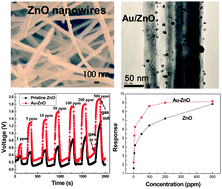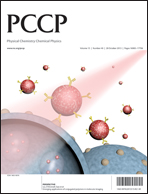A Au-functionalized ZnO nanowire gas sensor for detection of benzene and toluene†
Abstract
A novel sensing hybrid-material of Au nanoparticles (Au NPs)-functionalized ZnO nanowires (Au–ZnO NWs) was successfully synthesized by a two-stage solution process. First, ZnO NWs were fabricated via a low-temperature one-pot hydrothermal method with SDSN introduced as a structure-directing agent. Afterward, the as-prepared ZnO NWs were used as supports to load Au NPs with small sizes via precipitating HAuCl4 aqueous solution with ammonia. The obtained samples were characterized by means of XRD, SEM, TEM and EDX. Both pristine and Au–ZnO NWs were practically applied as gas sensors to compare the effect of Au NPs on the sensing performances and the obtained results demonstrated that after functionalization by catalytic Au NPs, the hybrid sensor exhibited not only faster response and recovery speeds but also a higher response to benzene and toluene than the pristine ZnO sensor at 340 °C, especially showing high selectivity and long-term stability for low concentration toluene, which is rarely reported with this method, indicating its original sensor application in detecting benzene and toluene. To interpret the enhanced gas sensing mechanism, the strong spillover effect of the Au NPs and the increased Schottky barriers caused by the electronic interaction between Au NPs and ZnO NW support are believed to contribute to the improved sensor performance.


 Please wait while we load your content...
Please wait while we load your content...